
There is a reason the Canada and Mexico Pavilions are located where they are along the World Showcase Lagoon. These two countries border the United States to the north and south and were thus given places of prominence along the promenade. Whether you tour World Showcase clockwise or counterclockwise, you’ll come to one of our national neighbors first. Today I’m going to talk about the Canada Pavilion and hopefully provide you with a few tidbits you didn’t already know.
Canada was perhaps one of the more difficult countries to portray in World Showcase. Not because it doesn’t have a rich heritage and culture, but because it shares much of its history, architecture, and topography with its neighbor to the south. How do you create a unique identity that is easily recognized as Canadian, yet doesn’t overlap with America?
Canada is the second largest country in the world. It spans six time zones and offers outstanding scenery from coast to coast. The Imagineers decided to use this boundless expanse and capture the natural elements of Canada’s sprawling landscape rather than focus on architecture. Yet, the structures that were selected are unique to this vast land. I think the Imagineers did a fantastic job. There is no mistaking the identity of this northern jewel among the World Showcase nations.
Let’s start our tour of the Canada Pavilion at the World Showcase Lagoon. Reference material tells us that this area was designed to resemble the rugged Canadian eastern seaboard. And it certainly does. However, I’ve often wondered if the Imagineers might also have been trying to suggest the Bay of Fundy as seen in the O’Canada movie.
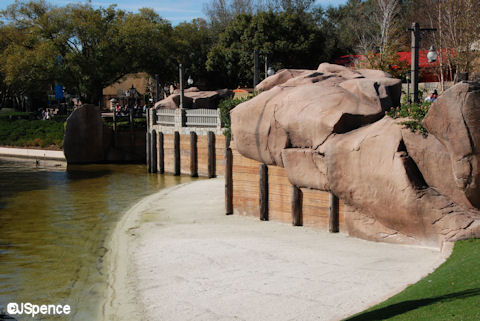
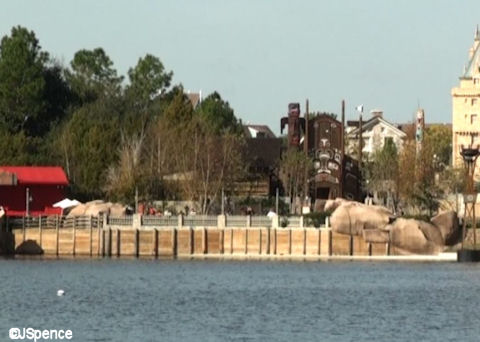
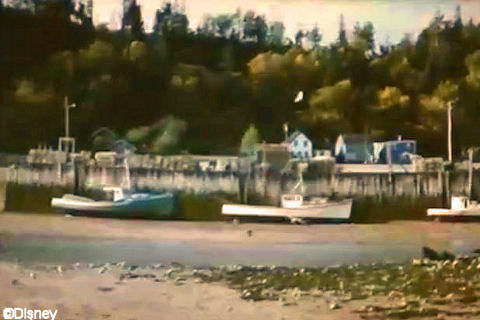
Located between the provinces of New Brunswick and Nova Scotia, the tidal changes at the Bay of Fundy range between 47.5 feet and 53.5 feet, the highest in the world. In July 2009, the Bay of Fundy was named as a finalist in a contest to select the New 7 Wonders of Nature; however, it was not chosen.
Next time you walk along the promenade of the Canada Pavilion, notice the picket fence. Maple leaves, the national symbol, are carved into every other plank.
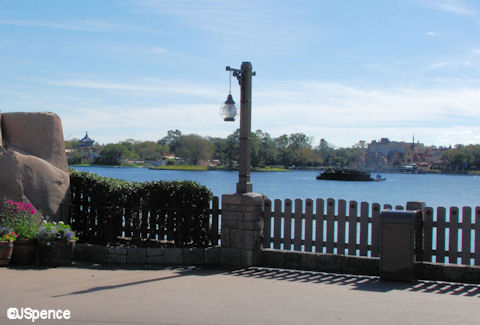
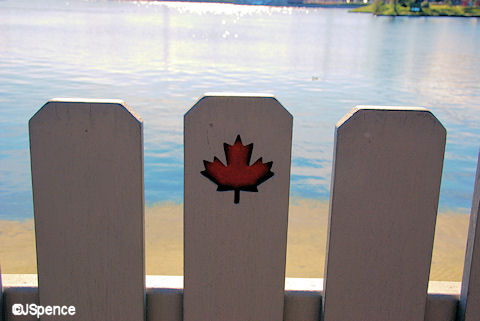
From the inception of World Showcase, regional entertainment was intended to be part of each nation’s offering – and the Canada Pavilion was no exception. In the early years, a group called “Caledonian Bagpipe Band” performed at both the Canada and United Kingdom Pavilions.
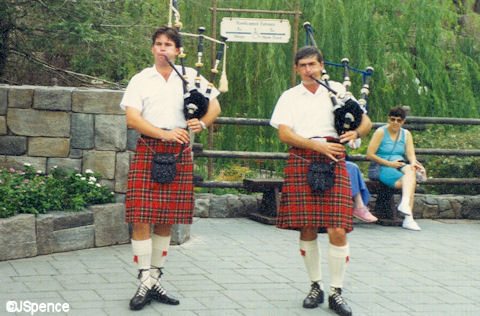
Although bagpipes can be traced as far back as 1000 BCE in the Middle East, they didn’t become commonplace in Europe until the 14th century and later. However, as classical music began to take hold, bagpipes fell out of favor due to their limited range and function.
When the British Empire was expanding during the 18th and 19th centuries, many of its units contained Highland regiments, groups that referred to Scotland in some part and had adopted items of Scottish dress and customs – which included bagpipes. Thus, the bagpipe became synonymous with many military companies. Today, the military forces of the United Kingdom and a number of its Commonwealth Nations such as Canada and New Zealand are known for their bagpipe bands which often play at formal ceremonies. In recent years, the revival of native folk music and dance has brought a resurgence of the bagpipes in popular culture.
In 1997, the Celtic-rock band Off Kilter was formed and became a permanent fixture at Epcot. Besides drums, fiddles, and guitars, bagpipes are a part of the instrumental makeup. The group became so popular that a permanent stage (The Mill Stage) and seating was erected shortly after their arrival. Unofficial surveys consistently select Off Kilter as one of the most popular live acts at Epcot. Although they perform a wide range of songs, they generally try to present pieces from Canadian artist and composers.
Senior AllEars Editor, Deb Koma, conducted an interview with Off Kilter’s founding member, Jamie Holton. To read it, click here.
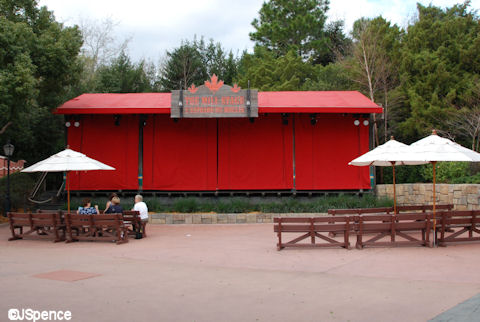
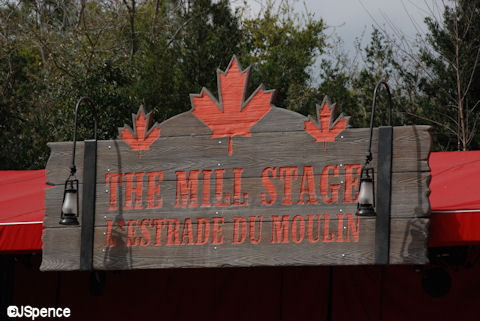
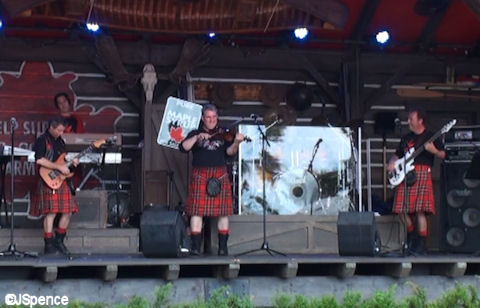
Now to that age-old question I know some of you are thinking, “What does a Scotsman wear beneath his kilt?”
Although I haven’t checked Off Kilter personally, I can assure you that EVERY cast member at Disney World is given a copy of “The Disney Look,” a booklet that outlines every aspect of the Disney grooming policy. It even stipulates that cast members must wear underwear while at work. So I have to assume that the Off Kilter band has broken with tradition and follows company guidelines. (Now that’s information you won’t read in most people’s blogs. LOL)
The aboriginal peoples of Canada’s Northwest Coast, specifically the First Nations tribes, were selected to represent the indigenous tribes of Canada. Their thousand mile stretch of homeland, bordered by the Pacific Ocean to the west and the Rocky Mountains to the east, isolated them from the rest of the country. In their isolation they became artisans and craftsmen. Representations of their handiwork can first be seen along the promenade where a great photo op presents itself.

As you ascend the steps to the pavilion, you are greeted by three totem poles, an art form peculiar to the Pacific Northwest. The meanings of the designs on totem poles vary from tribe to tribe. They can recount familiar legends, clan lineages, or notable events.
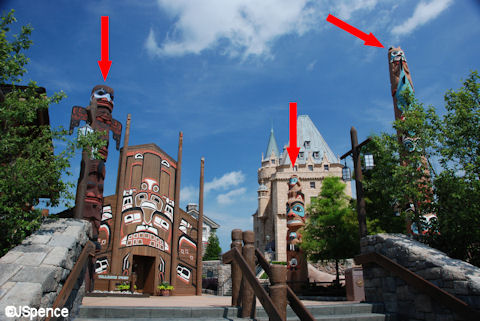
In the early years of Epcot, all three totem poles were made of fiberglass. In 1998, artist David Baxley carved a real totem pole as “performance art” at the Canada Pavilion. Upon its completion, it replaced the existing pole that sat adjacent to the shops. The story of this new pole tells of a Raven who tricks the Sky Chief into releasing the sun, the moon, and the stars from its chest. The first picture depicts the original, fiberglass totem pole. The second picture highlights the newer, wooden pole.

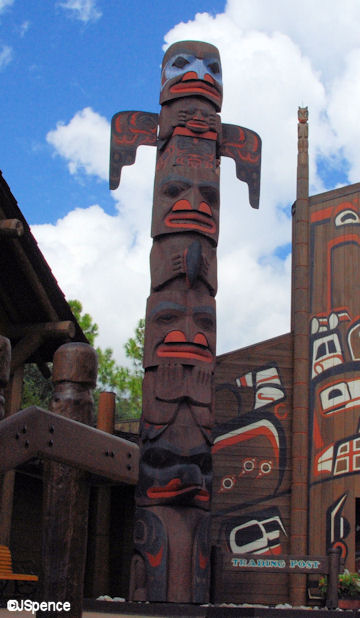
There are two shops on this level of the Canada Pavilion. The first is called Northwest Mercantile and pays homage to the French and English trappers, prospectors, loggers, and traders that helped open the vast western sections of Canada. If you pay attention while browsing in this store, you will find equipment necessary for surviving in the harsh environment of Canada’s wilderness. Items like these were the stock and trade of wilderness outposts during the frontier days.

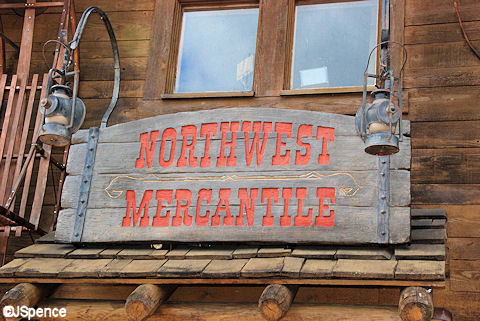
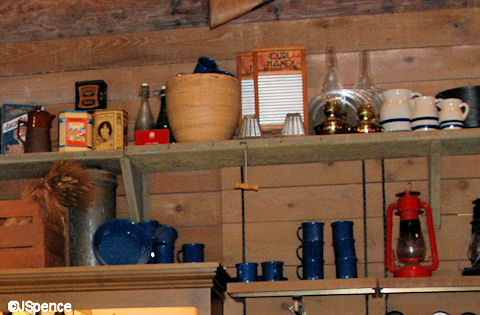
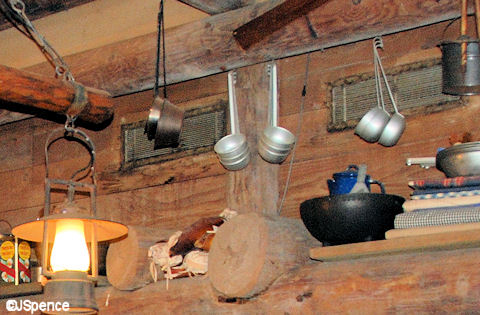
Next door is the Trading Post. Here, the Native American culture that thrived in Canada before the arrival of Europeans is exhibited. The building duplicates the adze-hewn log construction used by these ancient people. Inside, more totem poles and paintings are on display.

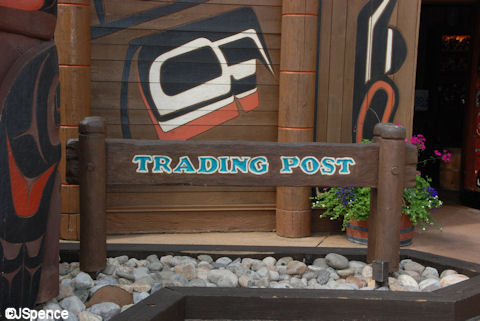
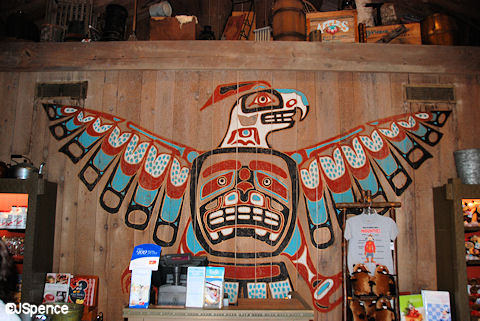
The merchandise sold in these adjoined stores is a collection of stereotypical Canadian souvenirs to useful items that can be used in real life.
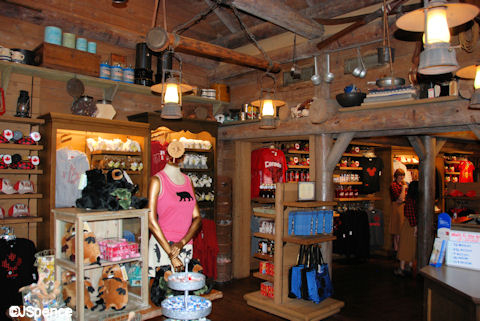
For you hockey fans, a number of shirts and other sports related items are available.
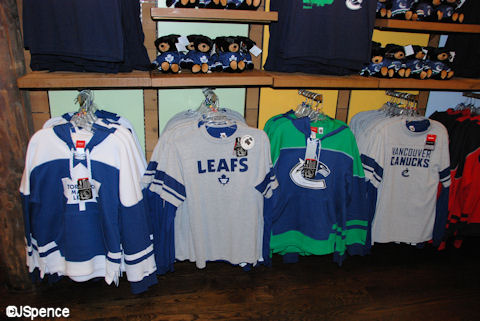
For the kids, I especially like these two t-shirts.
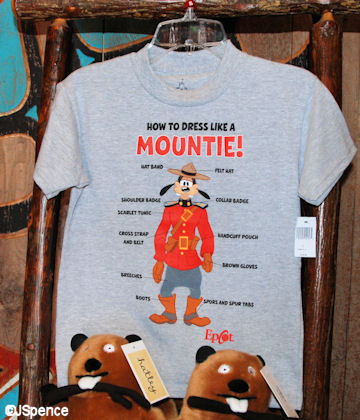
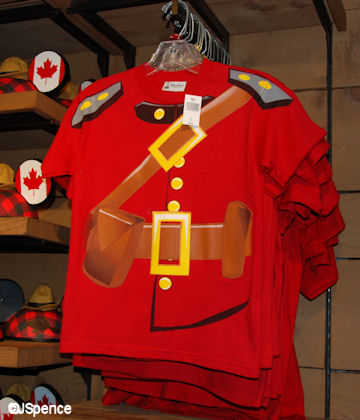
For the gourmet, several brands of real maple syrup can be found.
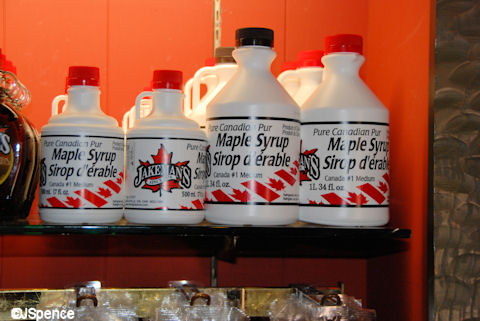
And for the ladies, a nice selection of body-care products by Fruits & Passions is for sale.
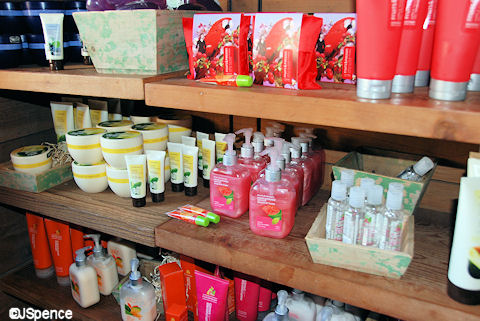
Early plans for the Canada Pavilion called for a “main street” of restaurants and shops. One side of the thoroughfare would represent French Canada while the other, English Canada. This idea was modified greatly, but in essence, it exists in the finished product. On the upper level of the Canada Pavilion, the country’s bicultural society is represented. On the right side of the street is Hôtel du Canada with its French architecture and on the left side of the street, English stone houses are patterned after those found in the maritime provinces of Prince Edward Island, Nova Scotia, and New Brunswick.

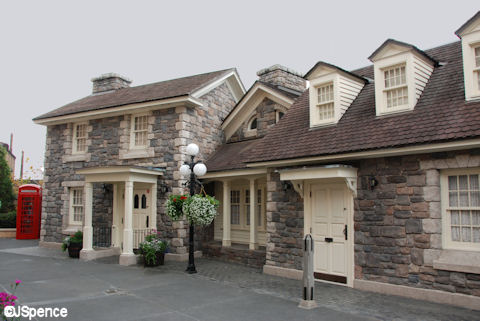
The first English settlement in the Maritimes was in Halifax. The style of construction methods that developed in this region was very close to the architecture found in New England as the trade links between these two areas was close and the topography similar. The New England and the Maritime Provinces are mountainous and rocky. Early settlers used what was on hand to build their homes and shops, and in the case of the Northern Eastern Seaboard, stones filled that need. Take a look at this Nova Scotia structure and compare it to its Epcot counterparts.
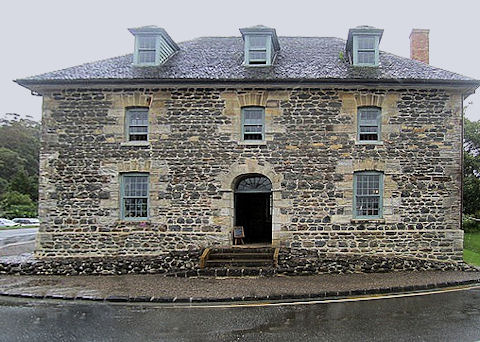

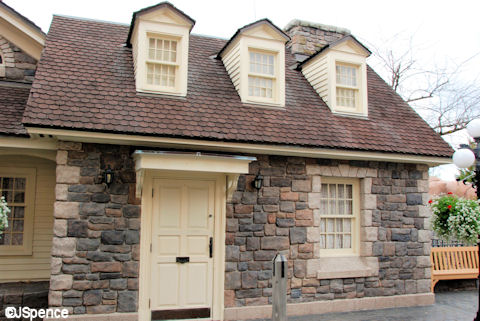
Original designs called for these “homes” to house the Canadian Tourism Information Center. But to my knowledge, this never came to pass.
Hôtel du Canada is the Canada Pavilion icon. It towers over the area with majestic beauty and grace. There is no mistaking this regal structure on the horizon.
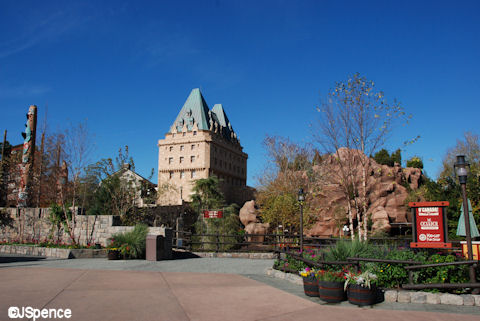

Hôtel du Canada was patterned after Chateau Laurier in Ottawa. The resort was commissioned by Grand Trunk Railway and was constructed between 1909 and 1912 in tandem with Ottawa’s downtown Union Station. Hotels like these were built all across Canada as the railroads pushed westward around the turn of the 19th/20th century. To promote passenger ridership and business, lines like the Grand Trunk Railway, Canadian National Railway, and Canadian Pacific Railway established a series of first class resort hotels along their routes. Many of these hotels do not exist today, and those that do, now belong to hostelry chains like the Fairmont, Westin, and others.
(I have had several readers comment that they believed Hôtel du Canada was inspired by structures other than Chateau Laurier in Ottawa. Looking at these other hotels, I agree that there are many similarities. I wouldn’t be surprised at all if the Imagineers used several hotels for their inspiration.)
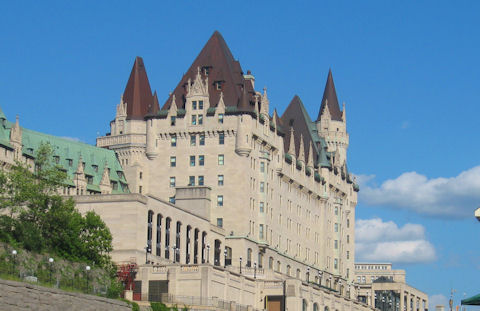
The next picture shows the Canadian National Hotels emblem. The second picture is Disney’s take on the logo which can be found on the side of the Hôtel du Canada.
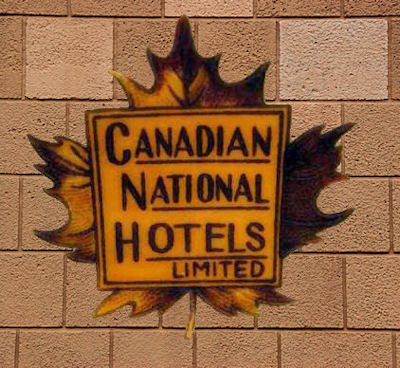

The architectural style used on Hôtel du Canada is Château. This term refers to the French country homes (châteaux) built in the Loire Valley from the late fifteenth century to the early seventeenth century. This style is noted for elaborate towers, spires, and steeply-pitched roofs.
You often hear Imagineers speak of “forced perspective.” This is a technique of making an object or structure appear larger than it actually is. The Hôtel du Canada is an excellent example of this trickery of the eye.
The actual structure is only three stories high, yet it appears to be seven. The first trick was to place the building on a hill. This truly does add height to the hotel. Next, the fiberglass stones are large at the base of the structure and grow smaller as they rise. And finally, the windows and other decorative items also become smaller the higher on the structure they are placed.
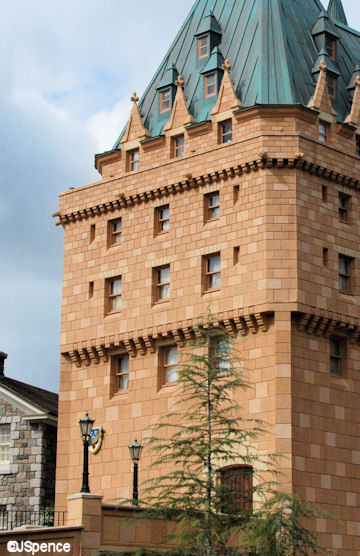
That’s it for Part One of the Canada Pavilion. Check back tomorrow for Part Two.



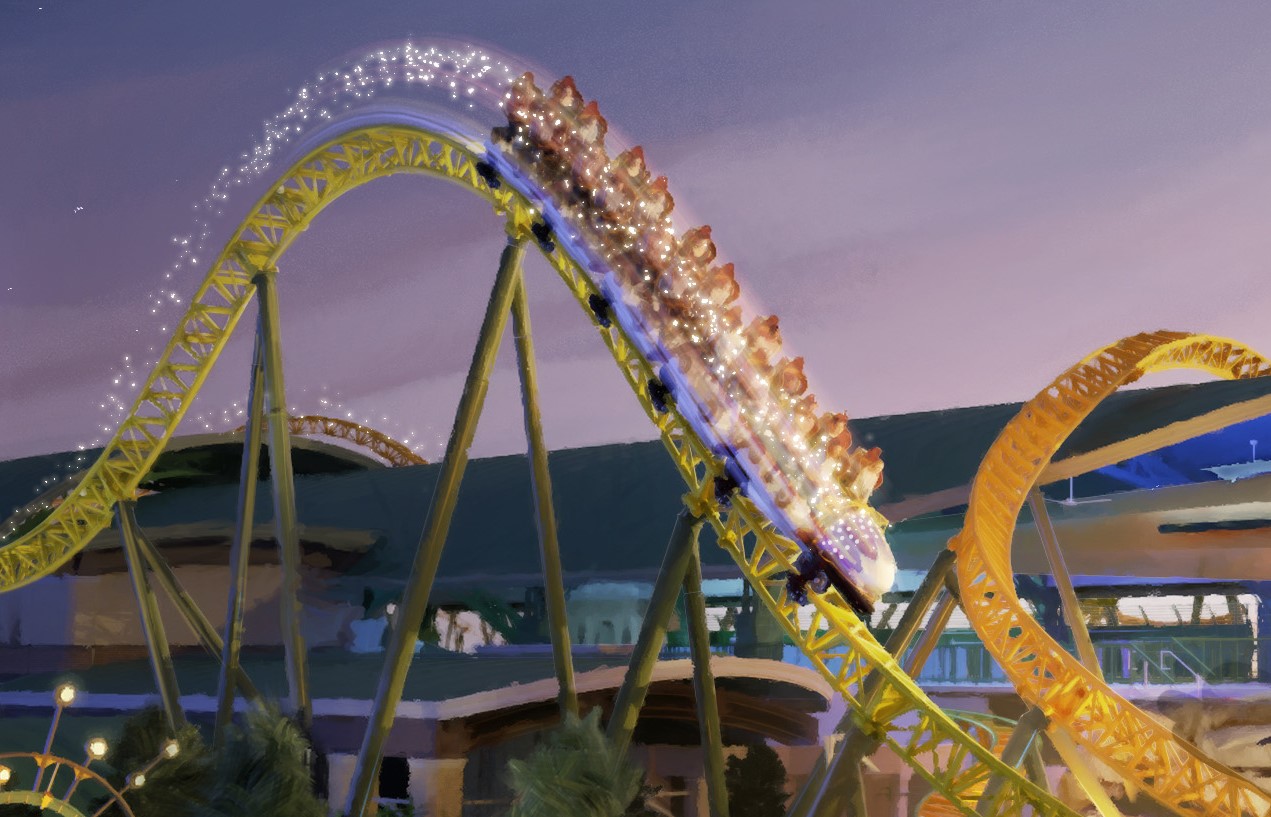
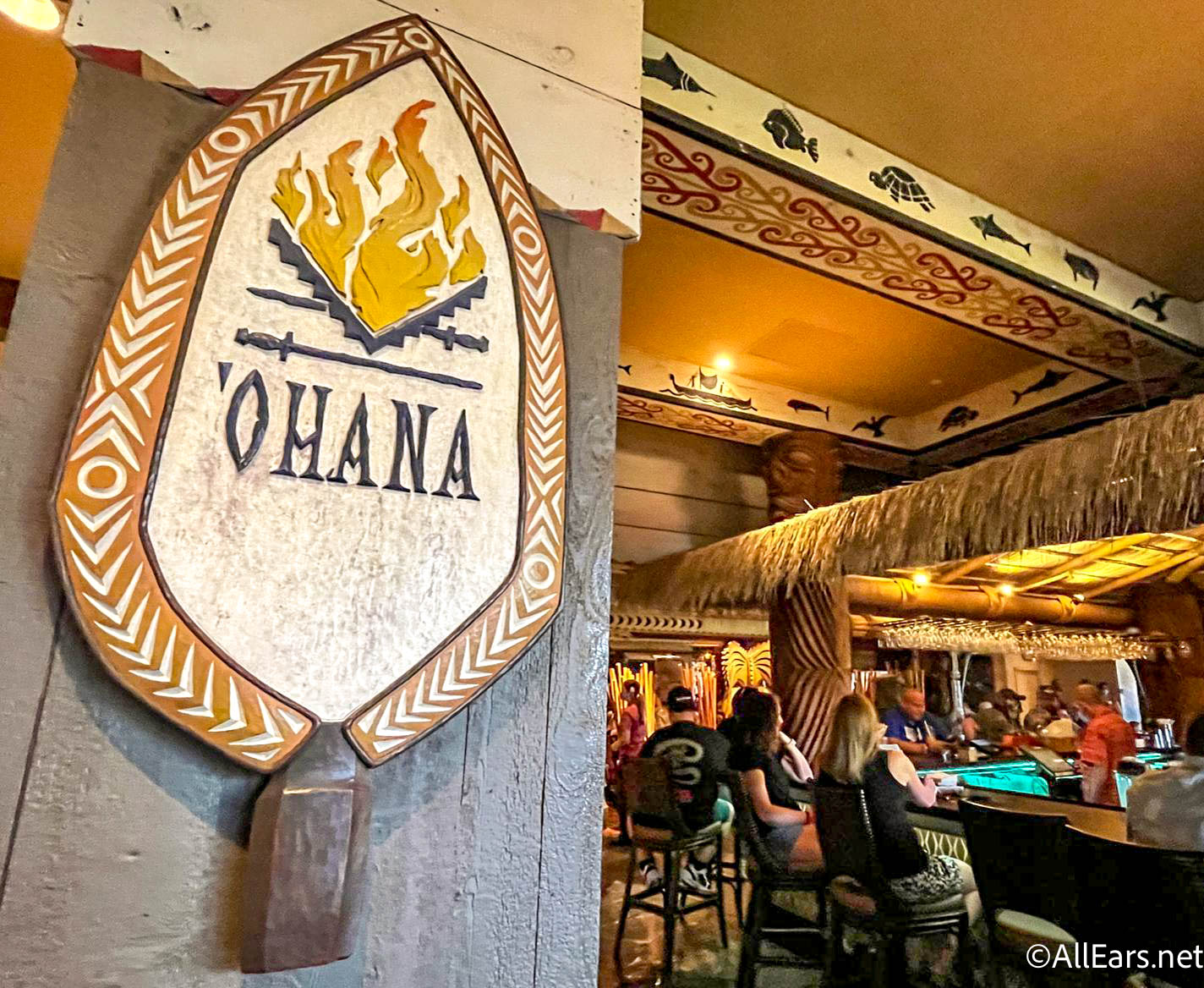
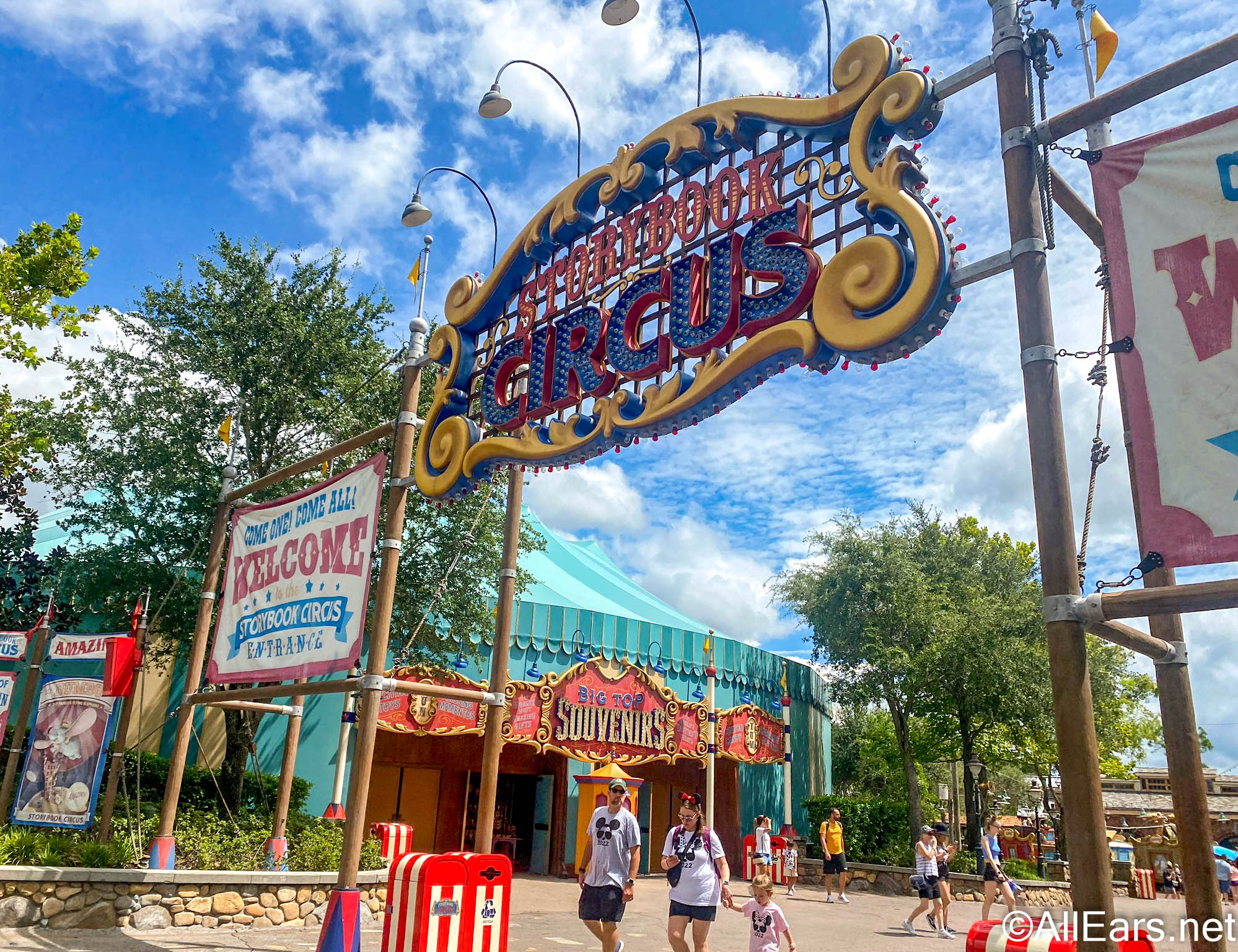
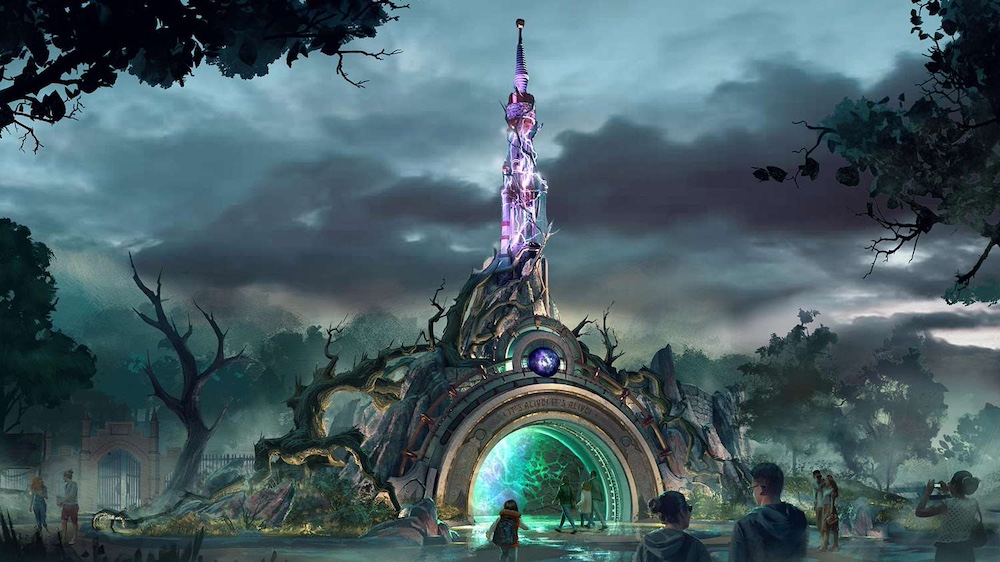

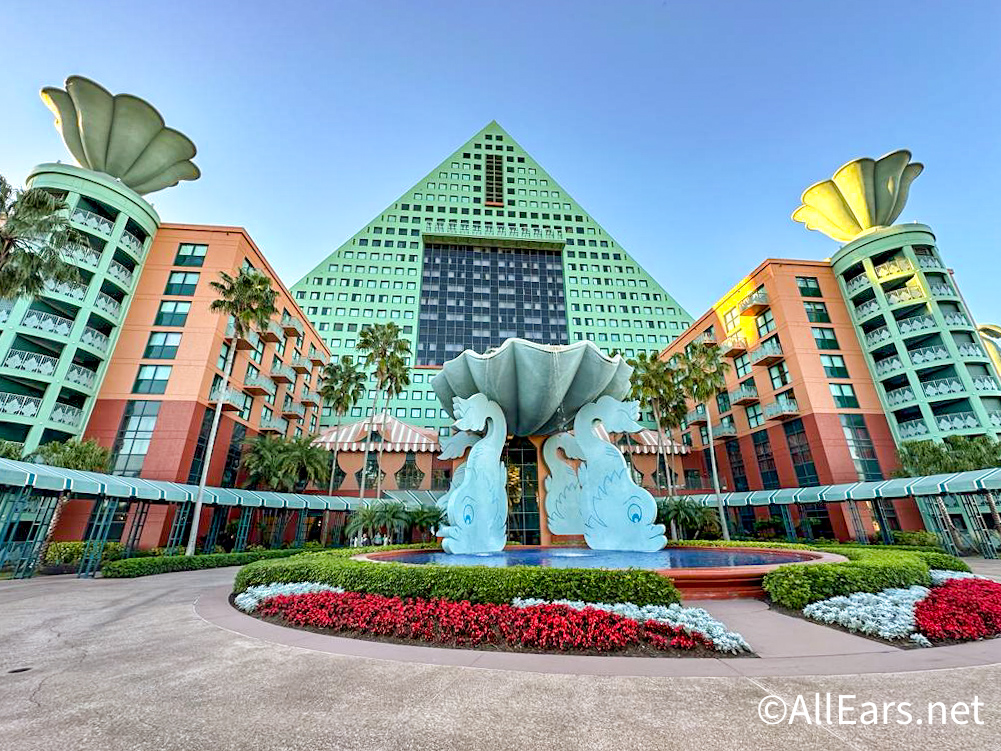

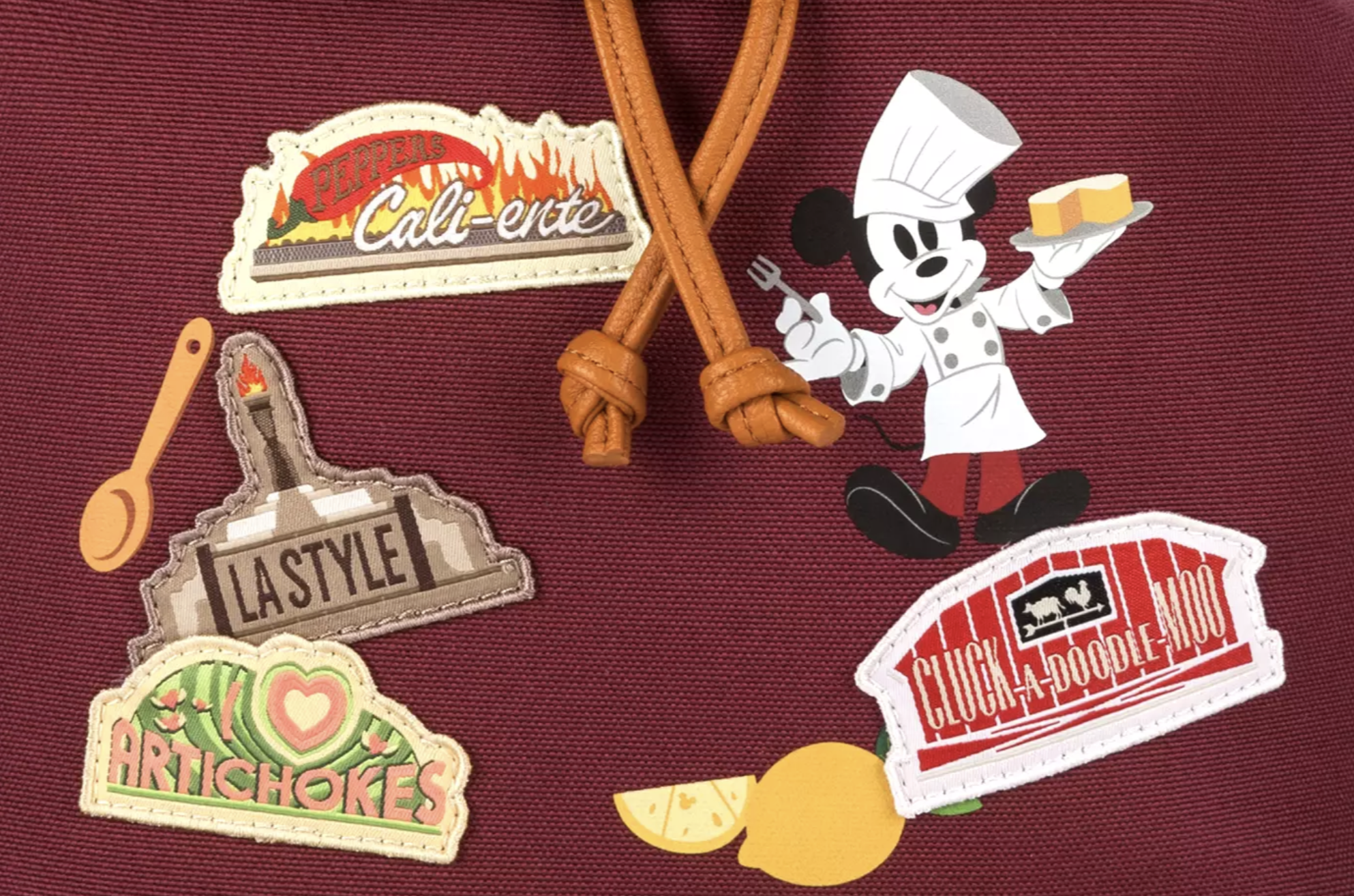
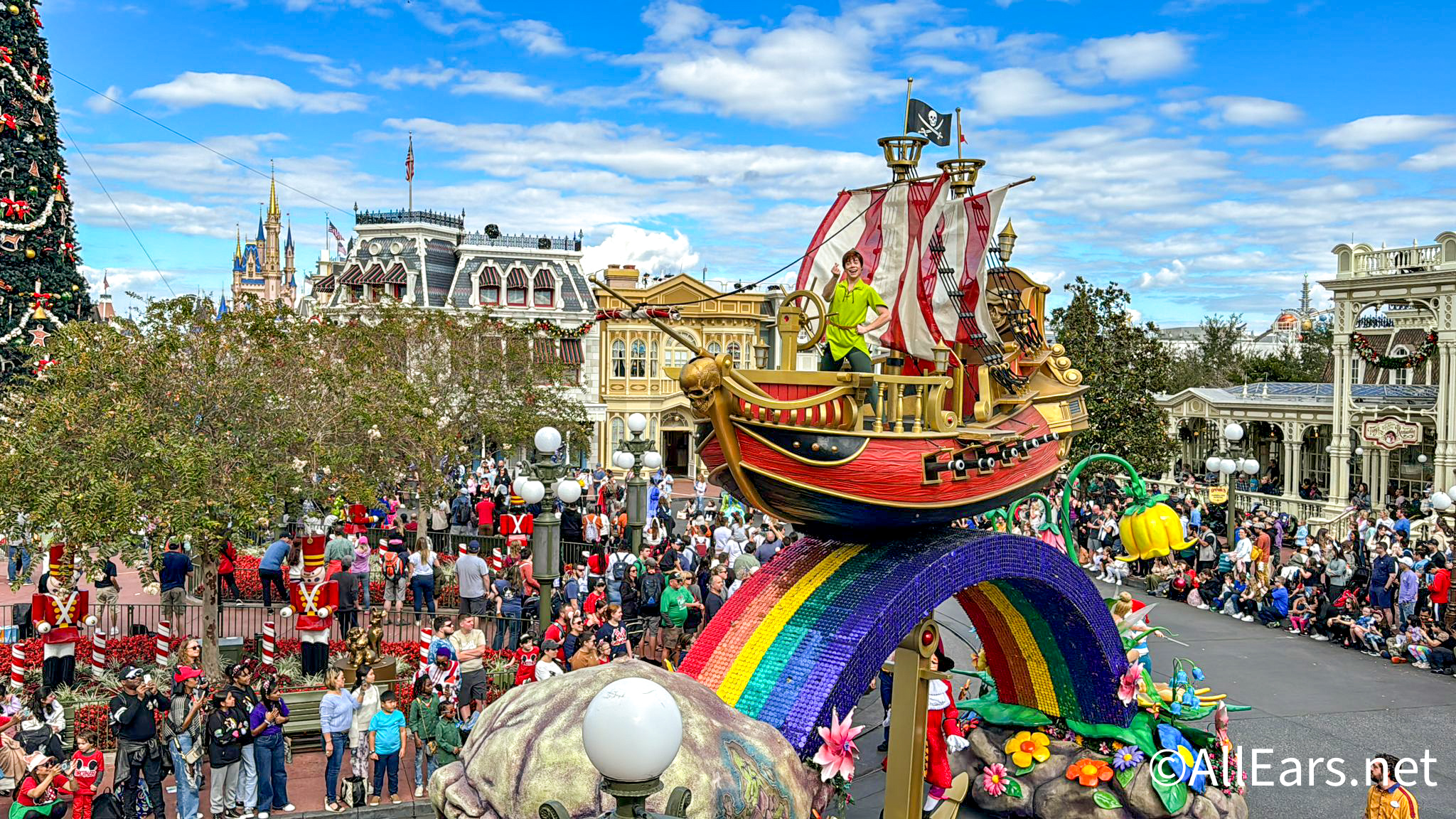
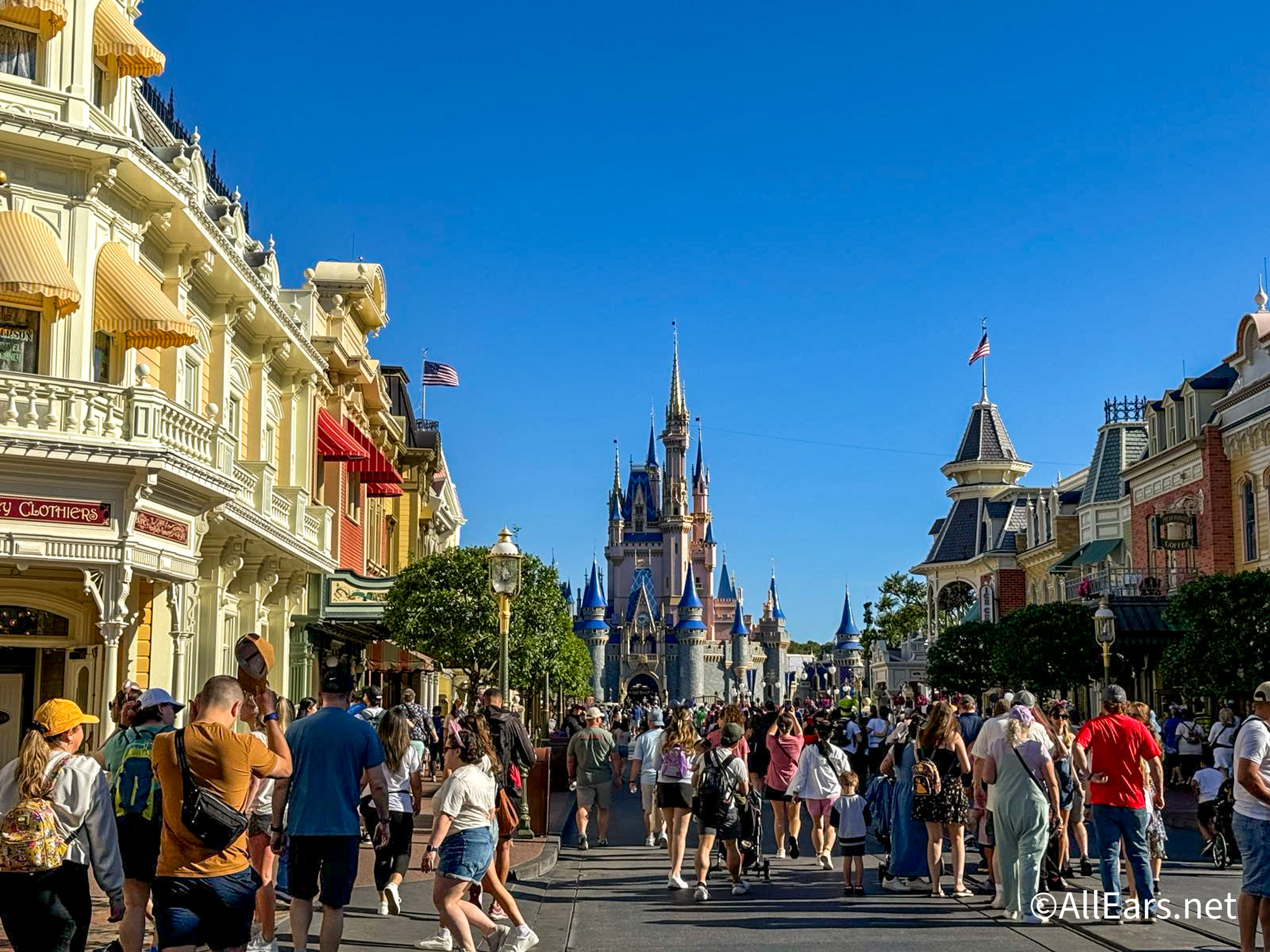




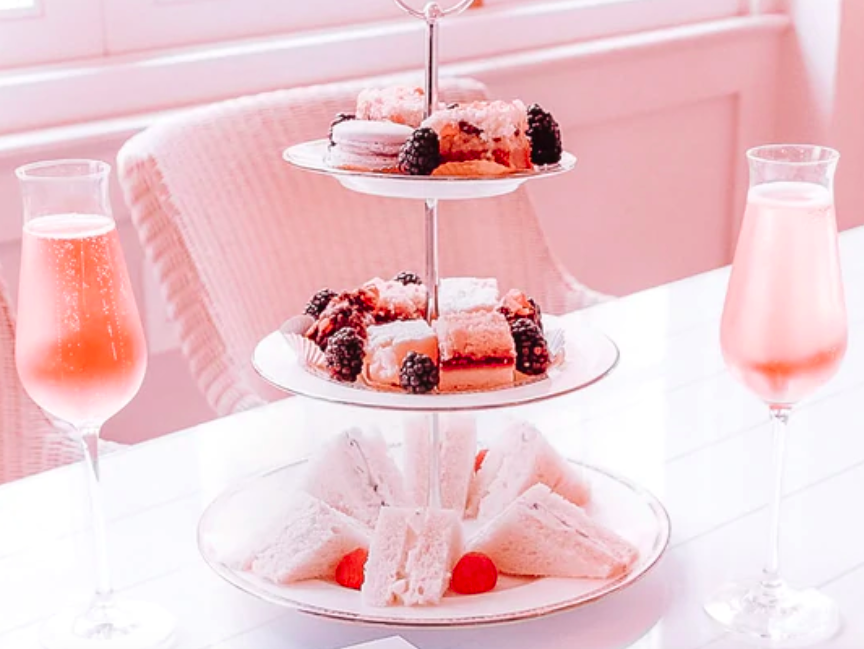

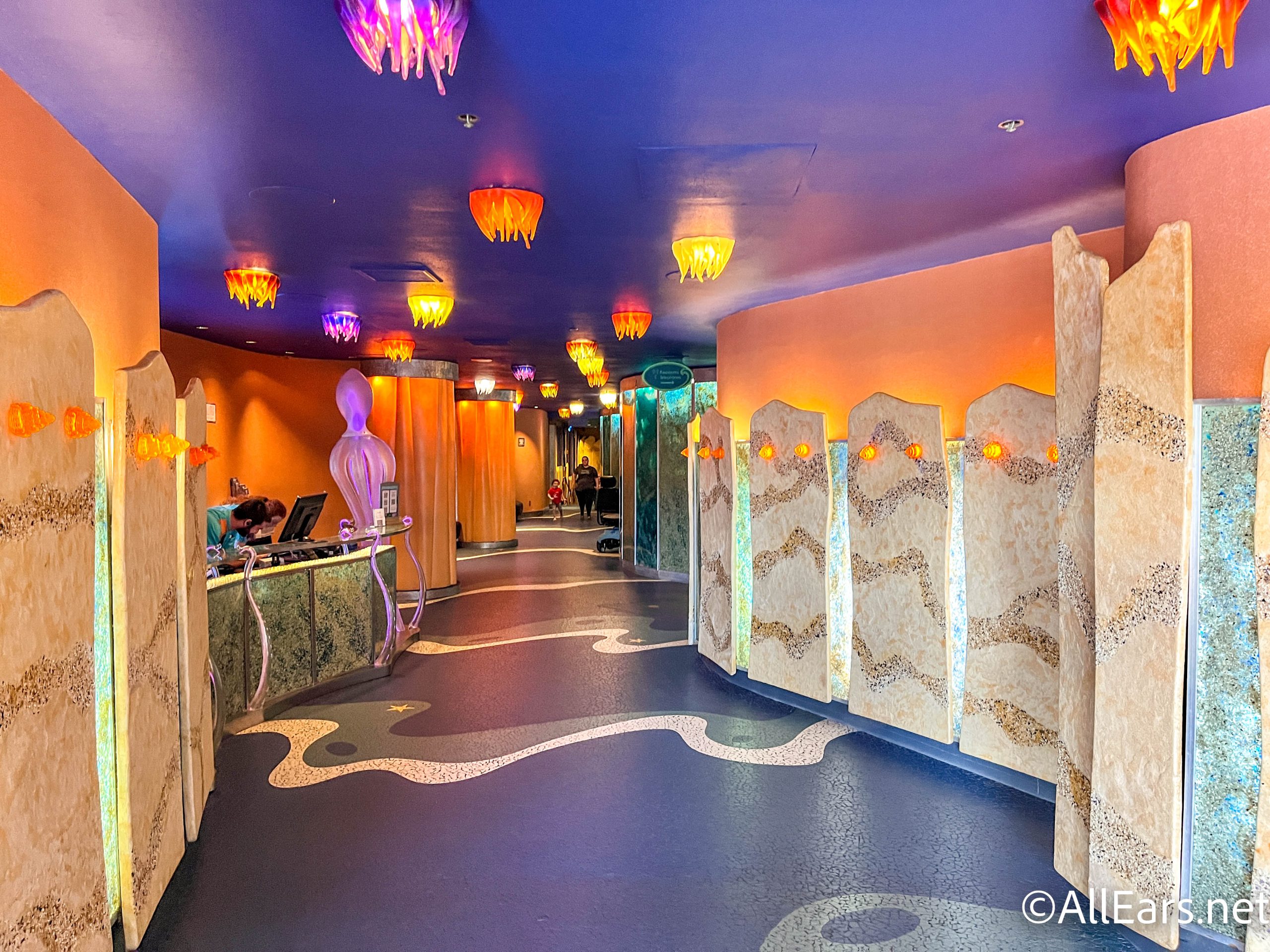
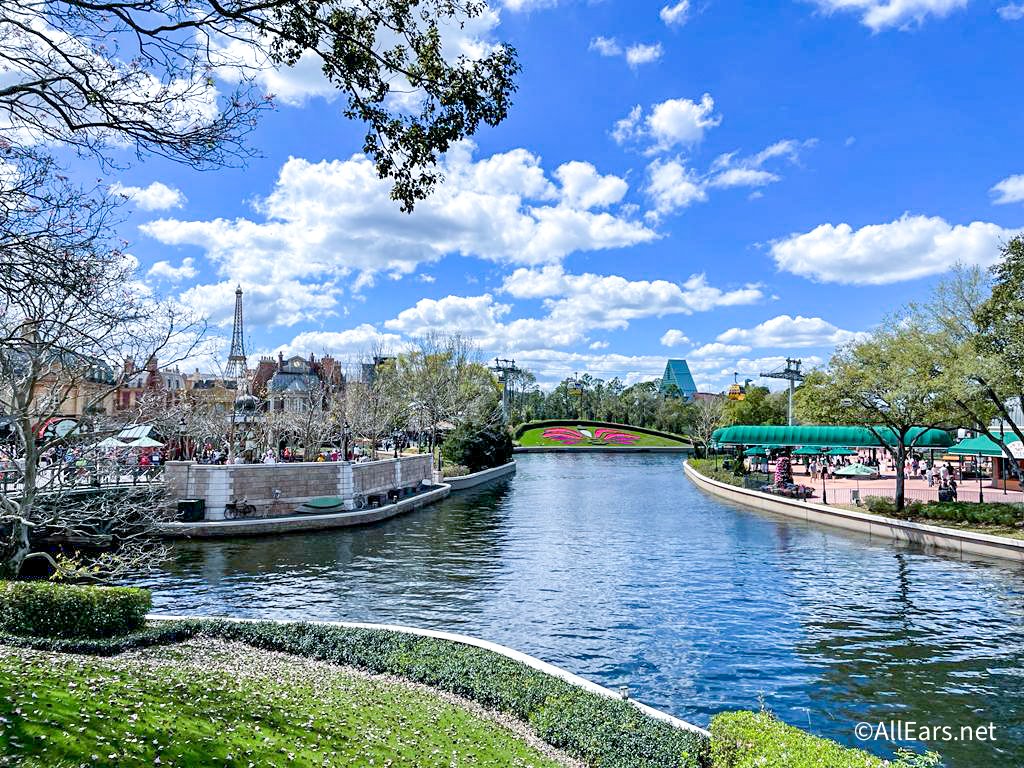

Wonderful blog post. I am apparently the only Canadian who has looked at the hotel and said “That’s the Chateau Laurier!”
It’s interesting that I have been to Epcot 7 times now, and I’ve never investigated the architecture beyond the shops. I’ll have to do that on my next trip.
Seems the one pavilion my wife and I spend the most time roaming through is the Canada pavilion. We’ve taken many “photo ops” along the railings bordering the sunken gardens. We live in Seattle and, as with any vacation…you sort of miss home at one point. Well, we just head over to EPCOT and spend time gazing at the gardens since they are based on the Butchart gardens in Victoria BC…our neighbor to the north and we’re refreshed and ready to explore some more. Great blog…Thanks!
Nice!!! I never truly spend much time in the Canada pavilion but I’ll be sure to devote more time when we go in May thanks to your blog.
Love these sort of blogs … interesting, informational, and a joy, thank you!!
I always thought it was based on the Chateau Frontinac (forgive my spelling) which is absolutely charming and beautiful in Quebec City.
I love all of the pavillions at Epcot, but Canada feels like the biggest wasted opportunity. So many pretty buildings and so little being done with them.
Jack,
Thanks for writing! I can’t believe how many years it took me to finally head to the Canada Pavilion and explore it fully. I cannot believe the beauty when you head all the way to the back and overlook the waiting area for the film. Beautiful, beautiful spot. I’m shocked that the building is only three stories tall!
Dan
I agree with your coment that the hotel du Canada was probably inspiered by few hotels. Until I read this I always thought that is was modled after the Farmont hotel at Lake Louise, Alberta Canada. Same color and everything.
Being a Canadian of course I loved this Blog.
Hi Jack,
Just to let you know the ‘First Nations’ is not a specific tribe. It is a term used to talk about the different tribes, bands or aboriginal peoples in all of Canada. I’m not sure what the specific tribe is, but as you said the different art comes from the Pacific coast region.
Jack,
Wonderful article as always!
I had to laugh when you got to the part about “what is worn under a kilt”. Though my husband and his brothers are “mutts”, they have embraced the Scottish part of their family tree when it comes to weddings and have all gotten married wearing a kilt and attend weddings wearing kilts. They all wear boxers underneath, because well….they are around their brothers so it’s a necessity.
However, mom was in Scotland shortly before my wedding and she asked about that. A couple of kilt wearing locals told her at one time it was traditional to “go commando” but nowadays most definitely do wear something underneath.
Since my brother was a groomsman in our wedding he now has a kilt as well and he and my husband plan to wear them when we see Off Kilter for our family trip this fall!
Thanks,
Sarah
I saw part two first. Happy to see Off Kilter mentioned here. I met them around ten years ago at Irish fests in Ohio. Loved them. Finally visited Epcot last August and I made an effort to see them! Only one replacement from the original but they were awesome! Not the typical thing I put with Canada but I know there is a huge Celtic influence in Eastern Canada. Off Kilter rocks!
Hi Jack,
A very interesting blog and I look forward to part II.
I didn’t realize that the original train station in Ottawa was also called Union Station (that building is now called the Government Conference Centre). I live only an hour from Ottawa and I’ve only been to the current train station they built in 1966 which is east of the downtown area.
Curiously enough the train station in Toronto is also called Union Station and I just assumed you had made a typo in your article until I looked it up – you learn something new everyday!
Wendy
good as always. i have a picture of the hidden mickey on the totem pole. wish more of the buildings were open
The Canadian Pavilion is beautiful but it does seem to be missing something. Of course like a true Canadian all would be improved with a Tim Horton’s coffee shop. I bet they would make a lot of money there to upgrade.
World Showcase Canada is one of my favorite countries and I always look forward to visiting when we go to Epcot. The falls that are in the back area are just beautiful.
When you referenced The Bay of Fundy and also why the country was placed where it is just blows my mind with the amount of thought and detail given to things that most people may not even recognize. It really makes me appreciate everyone involved in Imagineering.
Excellent job, Jack. Canada is one of the best-themed pavilions in World Showcase and one of my favorites, even if the movie has gone downhill a bit.
I used to work in Canada as a Merchie, and the rumour was that the shops up top failed due to guests not climbing the stairs to get to them. When guests were asked why they didn’t go up there, they replied that the stairs were a hindrance. No matter what Disney did, there just wasn’t enough traffic to the upper level shops.
There was also a rumour that one of them was going to be a wine shop, selling Canadian ice wine, but that didn’t come to pass. Other rumours: a log flume ride, a hockey museum…
There is so much potential for more in the Canadian pavilion. I wish the CTB would put some money into it.
Hi Jack,
I enjoyed this blog and on our next trip we will have to check out the picket fence because I don’t remember even seeing a fence.
A few years ago we took one of the tours offered at Epcot and our guide pointed out that there is a hidden Mickey on the one totem pole.
I went to my notes to check and it would be on the second totem pole underneath the arms at the top. I couldn’t see it in the photo though.
I was born and raised in Erie,PA which is just
hop and jump from this beautiful country so we visited often when I was a youngster.
Thanks Jack! This has to be my favorite of your blogs. I have visited Canada several times and have seen the Bay of Fundy and Chateau Frontenac. I love visiting Canada at Epcot to bring back memories of those vacations. I also love watching Off Kilter (I remember when Jamie was one of the Caledonian pipers) and O Canada, the movie. There are many scenes in there that I remember from my trips (and I am so glad they kept them in as the movie was filmed around the same time we were in those parts of Canada!).
I also miss the shop up the hill. We always stopped in there and I have several greeting cards I bought there of Pacific Northwest native art. I also remember when David Baxley was carving the totem pole – we stopped and talked to him about it. Thanks so much for giving me the year of that as I had no idea when it was, other than it was after I moved to Florida.
I think I could live in the Canadian pavilion. Now I need to get back to Epcot ASAP (well, after the Easter crowds disappear). Thanks again!
Great article as always. Love the Canada pavillion.
I may have missed this in your blog, but what is housed in the Hôtel du Canada?
Jack’s Answer:
You have to check back tomorrow for Part Two to find out. 🙂
Enjoyed the information about the Canadian Pavillion. Something my girls enjoyed doing in the shops was going on a search for certain stuffed animals and earning a certificate for finishing the task.
Great blog post.
Love to see posts about Canadian heritage and history, especially within the WDW experience. I too wonder about the unsued space in the top level.
Thank you for sharing!
hey jack
I love visiting canada whenever i visit disney world. it is always interesting to learn about the different architecture and history behind the buildings. I also love listening to the bagpipes and the band. can’t wait for part two tomorrow and as always keep up the great work.
i did learn a couple new thing, ? is that jamie holton in that picture of caledonian bagpipe band (on the left)
I have always believed the icon was modeled after the Chateau Frontenac in Old Quebec City. It is precisely the same materials down to the weathered copper roof. And the exact same placement of windows. It is far more of a close duplicate of the Quebec City chateau than the Ottawa one, in my opinion.
Jack’s Comment:
I just rechecked my sources and they definitely say the hotel is inspired by Chateau Laurier in Ottawa. But I certainly wouldn’t be surprised if the Imagineers used several Canadian hotels for their inspiration.
Another interesting blog Jack.
It’s a shame that the upper level of the pavillion is now unused. I seem to remember that in the early nineties it included a shop that sold fragrences and the cast members there used to dress in grey trousers and a pink shirt…very different to the costumes on the lower leval. I always thought they seemed a little out of place there.